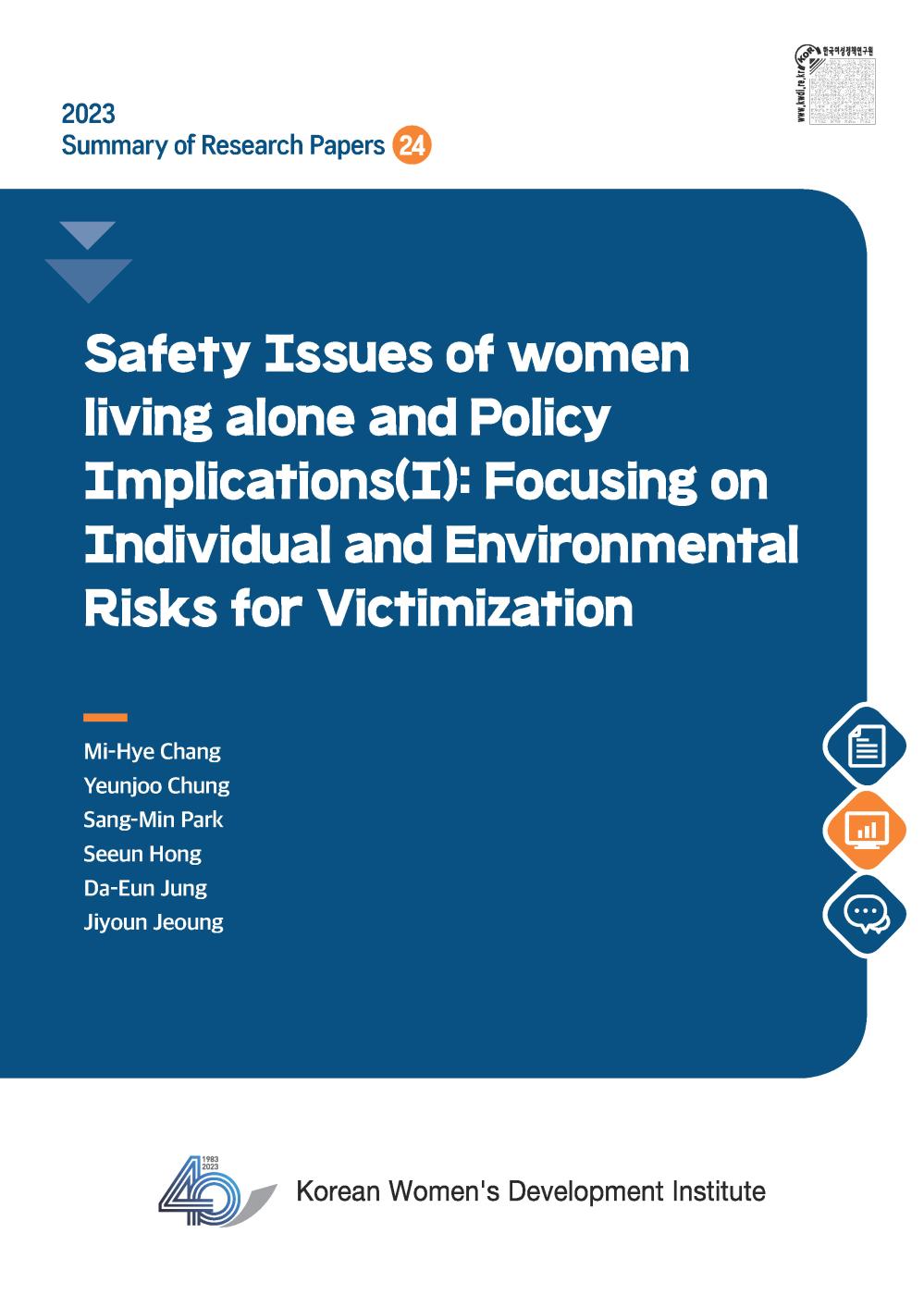Report
| Safety Issues of women living alone and Policy Implications(I): Focusing on Individual and Environmental Risks for Victimization | |||
|---|---|---|---|
| Type | Basic | Period | 2023 |
| Manager | Mi-Hye Chang | Date | 2023-12-29 |
| Fiie | 24_여성 1인가구의 안전 현황과 정책 대응 방안 (I) 범죄와 주거위험을 중심으로.pdf ( 1.74 MB ) | ||
|
Abstract Safety Issues of women living alone and Policy Implications(I): Focusing on Individual and Environmental Risks for Victimization Mi-Hye Chang Yeunjoo Chung Sang-Min Park Seeun Hong Da-Eun Jung Jiyoun Jeoung
This study aims to identify the current status and characteristics of female single-person households and analyze social problems, especially those related to safety that could arise due to the increase in female single-person households. Furthermore, by examining related laws, ordinances, and incumbent policies, the study created basis data to support customized policies. Based on such data, the study presented policy tasks to prevent crime risk for female single-person households.
In order to achieve the purpose of this study, cooperative research was conducted with the National Police University’s Public Security Research Institute. The main results derived from the research are as follows:
First, the legal basis for the safety policies for female single- person households needs to be reinforced. Currently, various policies supporting the safety of female single-person households are being implemented. But a legal basis must be secured in order for related policies to be implemented more organically and actively. To this end, existing laws can be reformed. There is also a need to consider enacting a separate independent law to support the safety of female single-person households.
Second, different entities have to coordinate and integrate with each other in terms of safety tasks. The safety vulnerability factors of female single-person households are overlapping and multidimensional. Thus, coordination is required among existing individual policies. However, the policies have been broken up into separate categories and assigned to different entities as follows: the Ministry of Land, Infrastructure and Transport - housing safety, Ministry of Gender Equality and Family – prevention of gender violence and sex crime, National Police Agency - public safety, Ministry of Health and Welfare - disease control, and Ministry of Public Administration and Security - life safety. Due to such a break up, coordination between safety projects is low.
In order to promote pan-governmental integrated safety policies and support projects for female single-person households in the future, manpower and an organizational structure to oversee or exclusively take charge of safety policies for female single-person households must first be established. A pan-departmental governance system including related ministries and local governments should be created.
Third, of safety policies customized by region and target should be implemented. As examined in this study, regions differ in terms of security situations and crime vulnerability factors. Therefore, regionally tailored policies should be implemented. Such policies should reflect the characteristics and security needs of female single-person households according to different regions. In terms of prevention, it would be more efficient to design safe buildings from the construction stage rather than remedy the crime vulnerabilities of existing buildings. As for multi-household residential areas in cities, it is often the case that such areas are vulnerable to crime and decrepit. Thus, emphasis needs to be placed on identifying crime vulnerabilities in existing buildings and setting up measures to address such vulnerabilities. Additionally, in areas such as shopping malls, entertainment districts, subways, and parks, the CPTED (Crime Prevention Through Environmental Design) approach appears highly effective. With this approach, lighting would be improved in entry ways to residential areas (ex.: street lamps, logojectors, sign posts, markings, wall colors). Lastly, not all female single-person households are alike. Generations differ in their safety needs. Therefore, when implementing preventive policies, the psychological characteristics of each generation have to be considered.
Fourth, the effectiveness of safety should be enhanced through cooperation. Projects related to the safety of female single-person households can be expected to be effective when promoted in an organic cooperative relationship between local governments and the police. Currently, cooperation between local governments and the police happens in the following manner. The local government has the budget to plan and operate safety projects. The police participate after the project has already been planned. However, a restructuring needs to take place where the police can be involved early on from the budget phase, particularly in the area of crime prevention. In addition, local governments and the police need to maintain a more stable and systematic network at the working level. Furthermore, if the police can cooperate with private security companies, such cooperation will contribute to more effective crime fighting capabilities with limited manpower. Data-based analysis should also be shared for collaboration.
Fifth, more emphasis should be placed on crime prevention based on science and technology. Usable data is essential to accurately identify crime risk factors in female single-person households and promote effective prevention policies. The police, prosecutors, and the Ministry of Public Administration and Security are disclosing more data on crime and safety than in the past. But so far, they have only disclosed aggregated data by city and province by year.
In order to analyze the exact cause and derive effective preventive measures through public safety and crime data, crime statistics specifically on women or female single-person households have to be subdivided in the crime statistics system. The subdivision would allow the preparation of more accurate data that can identify the actual state of crimes against women and female single-person households. Additionally, a directional change needs to take place where access to raw crime statistics data is made available to a wider public.
Research areas: Gender-based Violence / Safety Keywords: Living Alone, Safety, Crime Prediction, Crime Mapping, Neighborhoods |
|||
